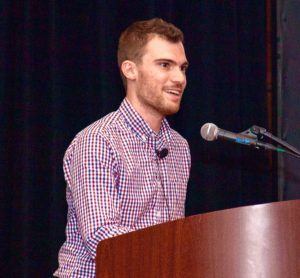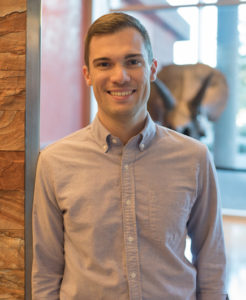Graduate Student Spotlight: Zachary Torrano
Zachary Torrano received his B.S. in Environmental Geosciences from the University of Notre Dame in 2015, and is currently enrolled in the final year of his Ph.D. at ASU, advised by Prof. Meenakshi Wadhwa.
As an undergraduate, Zack conducted nuclear forensics research in the University of Notre Dame’s High Temperature Isotope Geochemistry Laboratory from 2013–2015, and meteorite research as part of the Lunar and Planetary Institute Summer Intern Program in Planetary Science in 2014.
 Zack’s dissertation research involves the isotopic analysis of meteorites and their components to address outstanding questions about the dynamics and evolution of our early Solar System. His particular focus has been on mass-independent isotopic anomalies in the neutron-rich isotopes of Cr and Ti. These isotopes have a nucleosynthetic origin in supernovae and can be used to trace the incorporation of supernova materials into our Solar System, provide constraints on Solar System dynamics and mixing processes, and provide information on the genetic relationships between meteorites. To this end, he performs high-precision isotopic measurements using the Neptune MC-ICP-MS in ASU’s Isotope Cosmochemistry and Geochronology Laboratory.
Zack’s dissertation research involves the isotopic analysis of meteorites and their components to address outstanding questions about the dynamics and evolution of our early Solar System. His particular focus has been on mass-independent isotopic anomalies in the neutron-rich isotopes of Cr and Ti. These isotopes have a nucleosynthetic origin in supernovae and can be used to trace the incorporation of supernova materials into our Solar System, provide constraints on Solar System dynamics and mixing processes, and provide information on the genetic relationships between meteorites. To this end, he performs high-precision isotopic measurements using the Neptune MC-ICP-MS in ASU’s Isotope Cosmochemistry and Geochronology Laboratory.
His recently published paper "Titanium isotope signatures of calcium-aluminum-rich inclusions from CV and CK chondrites: Implications for early Solar System reservoirs and mixing", reported the Ti isotopic compositions of several calcium-aluminum-rich inclusions (CAIs), which were the first solids to form in the early Solar System. These results showed that CAIs from CV, CK, CO, CM, and ordinary chondrites formed in a common CAI-forming region that preserved some isotopic variability. This paper received an honorable mention for the 2018 Nininger Meteorite Award.
As well as taking an active role in the Center for Meteorite Studies outreach activities, such as Earth and Space Exploration Day, and ASU Open Door, Zack works closely with Center Meteorite Curator Dr. Laurence Garvie to select meteorites for his analyses. He is currently working with Center Assistant Research Scientist Dr. Jemma Davidson to reclassify a meteorite using Field Emission Electron Probe Microanalyzer data.
 In 2019, Zack was a recipient of the highly competitive and prestigious Future Investigators in NASA Earth and Space Science and Technology (FINESST) award. His proposal, "Using three isotope systems (Cr, Ti, and O) to address two important questions in planetary science via one sample suite of ungrouped chondrites: 3, 2, 1, Go!", was one of only 29 selected from over 290 applications in the Planetary Science division.
In 2019, Zack was a recipient of the highly competitive and prestigious Future Investigators in NASA Earth and Space Science and Technology (FINESST) award. His proposal, "Using three isotope systems (Cr, Ti, and O) to address two important questions in planetary science via one sample suite of ungrouped chondrites: 3, 2, 1, Go!", was one of only 29 selected from over 290 applications in the Planetary Science division.
Additionally, Zack was awarded Nininger Student Travel Awards in 2017 and 2018, a Barringer Crater Company Travel Award in 2017, a Planetary Studies Foundation Travel Award in 2019, and a Graduate Excellence Award from the College of Liberal Arts and Sciences in 2018. In 2019, he received a safety award from the School of Earth and Space Exploration, and he continues to promote a culture of safety, accuracy and precision in the Class 1,000 Isotope Cosmochemistry and Geochronology Laboratory.
Zack regularly presents his research at the annual Lunar and Planetary Science Conference, as well as the annual meeting of the Meteoritical Society. Click on the links below to read his most recent publications and abstracts!
Torrano Z. A., Brennecka G. A., Williams C. D., Romaniello S. J., Rai V. K., Hines R. R., and Wadhwa M. (2019) Titanium isotope signatures of calcium-aluminum-rich inclusions from CV and CK chondrites: Implications for early Solar System reservoirs and mixing. Geochimica et Cosmochimica Acta 263: 13-30.
Titanium Isotope Compositions of Refractory Inclusions: Implications for Nebular Mixing
Z. A. Torrano, V. K. Rai, M. Wadhwa
50th Lunar and Planetary Science Conference (2019), Abstract #1501